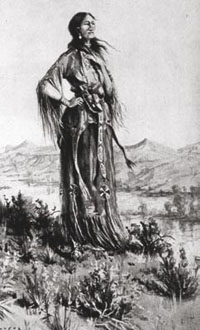国務省出版物
女性実力者の系譜-新世界への先導役「サカガウィア」

サカガウィア。E・S・パクスサンによる絵
特殊な才能を持つ開拓者
1786年頃生まれ、1812年12月20日死去
現在のアイダホ州に居住していたショショーニ族レムヒー集団の一員だったサカガウィアは、北米大陸の太平洋沿岸に至る地域を調査した1804-1806の年ルイス・クラーク探検隊で、彼女の強さと知力を発揮した。
幼い頃、サカガウィア(この名前は、おそらく「ボート運搬台」または「鳥のような女性」を意味する)は、敵対する部族に捕らえられ、トゥサン・シャルボノという名前のフランス系カナダ人毛皮商に売られたか、あるいは物々交換で引き渡され、後にシャルボノと結婚している。サカガウィアが16歳の頃らしいが、米国西部のダコタ地域にあるフォート・マンダンの近くで息子を出産した。
1805年、彼女の夫は、トマス・ジェファーソン大統領から太平洋までのルートを見つける命を受けた、メリウェザー・ルイスとウィリアム・クラークが率いる新結成の探検隊を支援するために雇われた。複数のインディアン方言を話すサカガウィアは、通訳として、またガイドとして、そしてこの探検隊の平和的な意図をさまざまな部族に示すシンボルとして、すぐに自分の実力を発揮し始めた。さらには彼女の兄が首長を務めているレムヒー集団に遭遇したときには外交官となり、遠征に不可欠なものだった馬や食料、避難所を提供するようレムヒー集団に掛け合った。サカガウィアはこの困難な旅に乳飲み子の息子ジャン・バティストをずっと伴い、世話をした。
遠征後、サカガウィアと夫は、ダコタに戻る前にしばらくセントルイスで暮らした。彼女は1812年に亡くなったと広く信じられているが、自分がサカガウィアだと主張する老女が1884年に死亡している。2000年、ある芸術家が想像で描いた、息子をあやすサカガウィアの姿が米国の1ドル・コインに付け加えられた。
「…われわれの通訳の1人の妻であるこのインディアン女性の姿は、われわれが友好的な目的を持っていることを彼らが確信したしるしだった。なぜなら、この地域では、インディアンの戦闘部隊に女性が同行することは決してないからだ」
1805年10月19日 ウィリアム・クラーク
*上記の日本語文書は参考のための仮翻訳で、正文は英文です。
Sacagawea - American women help the new nation - Women of Influence
(Born: c. 1786; Died: December 20, 1812)
A member of the Lemhi band of the Shoshone Indian tribe in present-day Idaho, Sacagawea demonstrated her strength and intelligence during the 1804-1806 Lewis and Clark expedition to explore the lands leading to the Pacific Coast of North America.
Early in her life, Sacagawea (a name possibly meaning "Boat Launcher" or "Bird Woman") was captured by a rival tribe. She was either sold or traded to a French-Canadian fur trader by the name of Toussaint Charbonneau, whom she later married. At approximately 16 years old, Sacagawea gave birth to a son in the vicinity of Fort Mandan in the Dakota territories of the western United States.
In 1805, her husband was hired to assist a newly formed expedition, led by Meriwether Lewis and William Clark, and charged by President Thomas Jefferson with finding a passage to the Pacific. Sacagawea, who spoke several Indian dialects, quickly proved herself – as an interpreter, as a guide, as a symbol to various tribes of the expedition's peaceful intentions, and even as a diplomat when the expedition encountered the Lemhi band, over which her brother was now chief. She arranged for the Lemhi to provide horses, provisions, and shelter, the very things that made the journey possible. Sacagawea transported and cared for her infant son, Jean Baptiste, throughout the difficult journey.
Following the expedition, Sacagawea and her husband lived for a time in St. Louis before returning to the Dakotas. She is widely believed to have died in 1812, although an elderly woman claiming to be Sacagawea passed away in 1884. In 2000, an artist's imaginary rendering of Sacagawea cradling her son was added to U.S. currency on a dollar coin.




